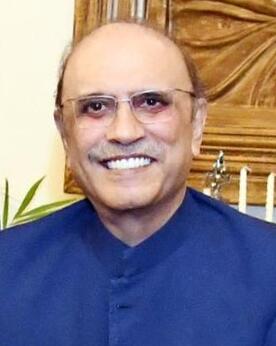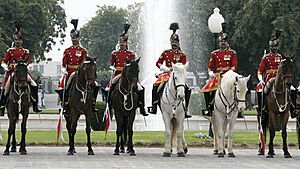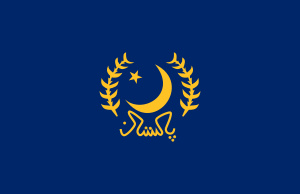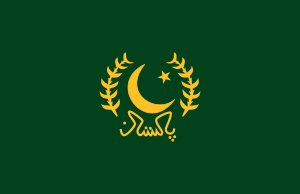President of Pakistan facts for kids
Quick facts for kids President of Pakistan |
|
|---|---|

Presidential Standard of Pakistan
|
|

|
|
| Head of state of the Islamic Republic of Pakistan Executive branch of the Government of Pakistan |
|
| Style | Honourable President (formal) His Excellency (diplomatic) Mr President (informal) |
| Residence | Aiwan-e-Sadr |
| Seat | Islamabad |
| Appointer | Electoral College |
| Term length | Five years
renewable once
|
| Constituting instrument | Constitution of Pakistan (1973) |
| Precursor | Monarch of Pakistan |
| Inaugural holder | Iskander Mirza |
| Formation | 23 March 1956 |
| Succession | Line of succession |
| Deputy | Chairman of the Senate |
| Salary | Rs 847,000 per month |
| Website | President of Pakistan |
The President of Pakistan (Urdu: صدرِ پاکستان, romanized: s̤adr-i Pākistān) is the head of state for the Islamic Republic of Pakistan. This means the President is the top representative of the country. They are also the supreme commander of the Pakistan Armed Forces.
The President's role is mostly ceremonial in Pakistan today. This means they perform important duties but usually act on the advice of the Prime Minister and the Cabinet. Asif Ali Zardari has been the current President since March 10, 2024.
The office of President was created on March 23, 1956. This happened when Pakistan became an Islamic Republic. The first President was Iskander Mirza, who was previously the Governor-General.
Over time, the President's powers changed a lot. After a military takeover in 1958, the Prime Minister's job was removed. This made the President the most powerful person. The 1962 Constitution made Pakistan a Presidential Republic. This gave the President all executive powers.
However, in 1973, a new Constitution was made. It brought back Parliamentary democracy. This made the President's role mostly ceremonial again. But a military takeover in 1977 changed things back. The 8th Amendment made Pakistan a semi-presidential republic. From 1985 to 2010, the President and Prime Minister shared power.
In 2010, the 18th Amendment was passed. This brought back Parliamentary Democracy fully. It made the President's job ceremonial once more.
The Constitution says the President cannot directly run the government. The Prime Minister handles executive power. The Prime Minister keeps the President updated on all important matters. This includes foreign policy and new laws. The President can grant pardons and has some control over the military. However, top military appointments need the Prime Minister's approval.
The President is chosen by the Electoral College. They serve for five years. To be President, a person must be a Muslim and at least 45 years old. The President lives in Aiwan-e-Sadar in Islamabad. If the President is away, the Chairman of the Senate takes over.
Pakistan has had 14 presidents. The first was Iskander Ali Mirza in 1956. The current President is Asif Ali Zardari. He took office on March 10, 2024.
Contents
President's Role and Powers
The President's Main Job
The President's official home and workplace is Aiwan-e-Sadr. This is the presidential palace in Islamabad. The President is an important part of the Parliament.
The President's powers are mostly for show. They are a ceremonial leader. They must address the Parliament. This helps guide national policies.
The President is also the civil commander-in-chief of the Pakistan Armed Forces. The Chairman Joint Chiefs is their main military advisor. This helps keep the military under civilian control. The President also confirms judicial appointments. This happens after the Prime Minister approves. The President can also grant pardons and reduce punishments. This is for cases recommended by the government or courts. The President has full legal protection while in office. No legal action can be taken against them.
There shall be a President of Pakistan who shall be the Head of State and shall represent the "unity of the Republic."
—Article 41 in Chapter 1: The President of Part III: The Federation of Pakistan in the Constitution of Pakistan, source
Making Laws
- The Parliament of Pakistan includes the President and two houses: the National Assembly and the Senate.
- The President must approve a new law within ten days. If they don't, it becomes law anyway.
- The President can call or end Parliament sessions.
- They can speak to either House or both Houses together.
- The President can send a law back to Parliament for changes.
- They can also send messages about a law being discussed.
- The President can dissolve the National Assembly if the Prime Minister advises it.
- They can issue special orders (ordinances) when Parliament is not meeting.
- The President approves the national budget law.
- They also approve changes to the Constitution.
Executive Duties
- The President is the ceremonial head of state. The Prime Minister and Cabinet use all executive powers on their behalf.
- The President must act on the advice of the Prime Minister or Cabinet.
- The President appoints federal ministers and state ministers. These are chosen from Parliament members, based on the Prime Minister's advice.
- They also appoint advisors and caretaker governments.
- The President appoints provincial governors.
- They appoint the chief election commissioner and members of the Election Commission of Pakistan. This is done after talking with the Prime Minister and opposition leader.
- The President receives foreign ambassadors.
- They host visiting heads of state.
- The President gives oaths to the Prime Minister and other ministers.
- The Cabinet and Prime Minister help and advise the President.
- The President can ask for a public vote (referendum) on important issues.
- They issue orders based on advice from the Prime Minister or ministries.
- The President sets the date for general elections after the National Assembly is dissolved.
Court-Related Powers
- The President appoints the Chief Justice of the Supreme Court. This is done after recommendations from a parliamentary committee.
- They appoint Chief Justices for High Courts in provinces and Islamabad.
- The President also appoints other judges to the Supreme Court and High Courts.
- They can remove a judge if the Supreme Judicial Council recommends it.
- The President approves the salaries of Supreme Court and High Court judges.
- They can transfer a High Court judge to another High Court. This needs the judge's agreement and discussion with the Chief Justice of Pakistan.
- The President can grant pardons, reduce sentences, or change punishments.
- They appoint Chief Justice and judges of the Federal Shariat Court.
- The President can refer laws to the Islamic Ideology Council for review.
- They give oaths to the Chief Justice of Pakistan and the Chief Justice of Islamabad High Court.
Appointment Powers
- The President appoints the Attorney General and Auditor General.
- They appoint the Controller General of Accounts and Advocate General Islamabad.
- The President also appoints members and chairpersons of various councils. These include the Council of Islamic Ideology and the National Economic Council.
- They appoint the Governor of the State Bank of Pakistan.
- The President appoints various ombudsmen, like the Federal Ombudsman.
- As chancellor of federal public universities, they appoint vice-chancellors.
- They appoint the Chairman and members of the Federal Public Service Commission.
Military Powers
- The President is the Supreme Commander of the country's Armed Forces.
- They appoint the Chief of Army Staff, Chief of Naval Staff, and Chief of Air Staff. They also appoint the Chairman Joint Chiefs of Staff Committee. These appointments are made on the Prime Minister's advice.
- The President can create and maintain the military forces.
- They can set the salaries and allowances for military personnel.
- The President can send troops to other countries or the United Nations. This is done on the Prime Minister's advice.
- They can declare war and peace settlements. This also requires the Prime Minister's advice.
Emergency Powers
The President can declare an emergency in certain situations:
- National Emergency: If Pakistan's security is threatened by war, outside attack, or major internal problems.
- Suspension of Rights: During an emergency, the President can temporarily stop some basic rights.
- Provincial Emergency: If a province's government cannot function due to political issues or law and order problems.
- Financial Emergency: If the country's economy or financial stability is at risk.
The President can impose governor rule in any province. This means they can run the provincial government directly. These emergency powers are used on the advice of the Prime Minister and Cabinet.
From 2000 to 2009, the President was the head of the National Security Council. This gave them control over nuclear weapons. However, these powers were later transferred back to the Prime Minister. The President's powers have greatly decreased since 2010. Pakistan is now a parliamentary democratic republic.
Powers Before 2010
Before the 18th Amendment in 2010, the President was much more powerful.
The President could choose and appoint the Prime Minister. They could also dissolve the National Assembly. This happened if the government could not run according to the Constitution. Presidents like Zia Ul Haq, Ghulam Ishaq Khan, and Farooq Leghari used this power. This made the President more powerful than the Prime Minister.
- The President could appoint provincial Governors.
- They could appoint the heads of the Army, Navy, and Air Force.
- The President was the chairman of the National Security Council. This meant they made decisions about national security and defense.
- They were also the chairman of the National Command Authority. This body makes decisions about nuclear weapons.
- The President could appoint the Chief Election Commissioner without consulting anyone.
- They could appoint caretaker governments without consultation.
- The President could appoint Supreme Court and High Court judges.
- They could ask for a public vote on important issues.
- The President could make decisions about the country's foreign policy.
Becoming President
Who Can Be President?
The Constitution of Pakistan lists the main requirements for a President. A person must be:
- A citizen of Pakistan.
- A Muslim.
- At least 45 years old.
- Qualified to be a member of the National Assembly.
How is the President Chosen?
When the President's office is empty, the electoral college chooses a new one. This college includes members from both houses of Parliament (the Senate and National Assembly). It also includes members from the four provincial assemblies.
The chief election commissioner manages the election. Voting is done secretly. Each elector casts a different number of votes. The goal is for Parliament's votes to equal the provincial legislators' votes. Each provincial assembly has the same number of votes, based on the smallest assembly (Balochistan Assembly with 65 seats).
The Constitution also says the election must happen within a specific time. It should be no earlier than 60 days and no later than 30 days before the current President's term ends.
Election and Oath
The President is elected indirectly for a five-year term. A President can be re-elected but cannot serve more than two terms in a row. The President must take an oath in front of the Chief Justice. In this oath, they promise to protect and defend the Constitution.
I, (The name of the President-elect), do solemnly swear that I am a Muslim and believe in the Unity, and Oneness of Almighty Allah, the Books of Allah, the Holy Qur'an being the last of them, the Prophethood of Muhammad (peace be upon him) as the last of the Prophets and that there can be no Prophet after him, the Day of Judgment, and all the requirements and teachings of the Holy Quran and Sunnah:
That I will bear true faith and allegiance to Pakistan:
That, as President of Pakistan, I will discharge my duties, and perform my functions, honestly, to the best of my ability, faithfully in accordance with the Constitution of the Islamic Republic of Pakistan and the law, and always in the interest of the sovereignty, integrity, solidarity, well- being and prosperity of Pakistan:
That I will not allow my personal interest to influence my official conduct or my official decisions:
That I will preserve, protect and defend the Constitution of the Islamic Republic of Pakistan:
That, in all circumstances, I will do right to all manner of people, according to law, without fear or favour, affection or ill- will:
And that I will not directly or indirectly communicate or reveal to any person any matter which shall be brought under my consideration or shall become known to me as President of Pakistan, except as may be required for the due discharge of my duties as President. May Allah Almighty help and guide me (Ameen).
What Happens if the President Leaves Office?
The Constitution talks about who acts as President if the office is empty. Pakistan does not have a Vice President. So, other officials can step in:
- The Chairman of the Senate of Pakistan.
- The Speaker of the National Assembly.
The President can also be removed from office before their term ends. This is called impeachment. It can happen if the President violates the Constitution of Pakistan.
The impeachment process can start in either house of Parliament. The house makes charges against the President. These charges are in a notice signed by a two-thirds majority. The notice is sent to the President. Fourteen days later, it is discussed.
A resolution to impeach the President needs a two-thirds majority vote. The Speaker of the National Assembly then calls a joint session. The President has the right to defend themselves.
If the resolution passes with a two-thirds majority, the President loses their office immediately. This happens if they are found unfit or guilty of violating the Constitution. No President has been impeached so far. However, there was an attempt to impeach former President Pervez Musharraf in 2008. He resigned after the process began.
List of Presidents
History of the Presidency
Early Days
From 1947 to 1956, the Governor-General acted as the head of state. This was on behalf of King George VI and later Queen Elizabeth II. When Pakistan became an Islamic republic in 1956, the Governor-General was replaced by the President. Iskander Mirza became Pakistan's first President. He reportedly suspended the Constitution of Pakistan of 1956 in 1958. He then appointed General Ayub Khan as the first Chief Martial Law Administrator. Ayub Khan later took over the presidency.
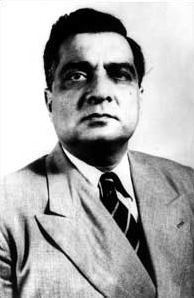
The Constitution of Pakistan of 1962, introduced by President Ayub Khan, made Pakistan a presidential republic. This meant the President had a lot of power. However, due to public pressure, Khan held an election in 1965. He won against Fatima Jinnah for a second term.
After some political issues and a war with India in 1965, Ayub Khan handed the presidency to General Yahya Khan. Yahya Khan declared martial law and announced elections for 1970. The elections took place. The PPP won most seats in West Pakistan. The Awami League won most seats in East Pakistan.
When a compromise could not be reached, President Yahya Khan invited Nurul Amin to be Prime Minister. He also made him the first Vice President. Violence in East Pakistan led to the Bengali resistance. This escalated into another war with India in 1971. This war led to the creation of Bangladesh.
After the events in East Pakistan, President Yahya Khan resigned. Power went to Zulfikar Ali Bhutto. President Bhutto created the current Constitution of Pakistan in 1973. This made Pakistan a parliamentary democracy. It reduced the President's powers to a ceremonial role.
Past Changes in Power
The 1977 elections led to public unrest. This resulted in military intervention by General Zia-ul-Haq. He suspended the Constitution in 1977. General Zia-ul-Haq became President in 1978. His time as President saw the growth of certain ideas in the country.
Under pressure to bring back the Constitution, President Zia-ul-Haq held a referendum in 1984. He then called for elections in 1985. President Zia-ul-Haq appointed Mohammad Junejo as Prime Minister. He gained more powers through a constitutional amendment. After dismissing Prime Minister Junejo, President Zia-ul-Haq announced new elections. However, President Zia died in a plane crash in 1988.
The 1988 elections led to the PPP winning. Senate Chairman Ghulam Ishaq Khan became President. There were disagreements between Prime Minister Benazir Bhutto and President Ghulam Ishaq Khan. President Ghulam Ishaq Khan dismissed Prime Minister Benazir Bhutto in 1990. After new elections in 1990, Nawaz Sharif became Prime Minister. President Ghulam Ishaq Khan tried to dismiss Sharif but failed. Both President Ghulam Ishaq Khan and Prime Minister Nawaz Sharif resigned in 1993.
After the 1993 elections, Prime Minister Benazir Bhutto formed a strong government. She appointed Farooq Leghari as President. However, President Farooq Leghari later dismissed Prime Minister Benazir Bhutto in 1996. In 1997, President Farooq Leghari could not overcome the strong public support for Prime Minister Nawaz Sharif. President Leghari resigned, ending a conflict between the courts, the government, and Parliament. After appointing Rafiq Tarar, Parliament passed a constitutional amendment. This greatly limited the President's powers.
In 1999, General Pervez Musharraf took power. He dismissed Prime Minister Nawaz Sharif and President Rafiq Tarar in 2001. He took on more powers for the presidency. President Musharraf had disagreements with the courts. He declared a state of emergency in 2007. He removed senior judges from the Supreme Court. Although Musharraf was elected in 2007, his rule was questioned. A public movement eventually led to Musharraf's departure. On August 22, 2008, nominations for President were called for. Elections were held on September 6, 2008.
The President Today
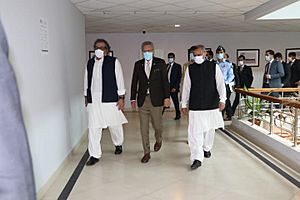
After the 2008 presidential election, Asif Ali Zardari became President. He worked to restore the Constitution to its 1973 form. In 2010, Parliament passed the Eighteenth Amendment. This removed many presidential powers. It changed Pakistan from a semi-presidential system to a parliamentary republic. This change aimed for more stable government in the future.
See also
 In Spanish: Presidente de Pakistán para niños
In Spanish: Presidente de Pakistán para niños
- Principal Secretary to the President of Pakistan
- Air transports of heads of state and government
- Official state car
- Prime Minister of Pakistan
- Chief Justice of Pakistan
- Chief Justice of the Federal Shariat Court
- Chief of Army Staff of the Pakistan Army
- Constitution of Pakistan
- Wafaqi Mohtasib (Federal Ombudsman)
- Foreign Minister of Pakistan
- Finance Minister of Pakistan
- Interior Minister of Pakistan
- Minister of Defence (Pakistan)
- Vice President of Pakistan


